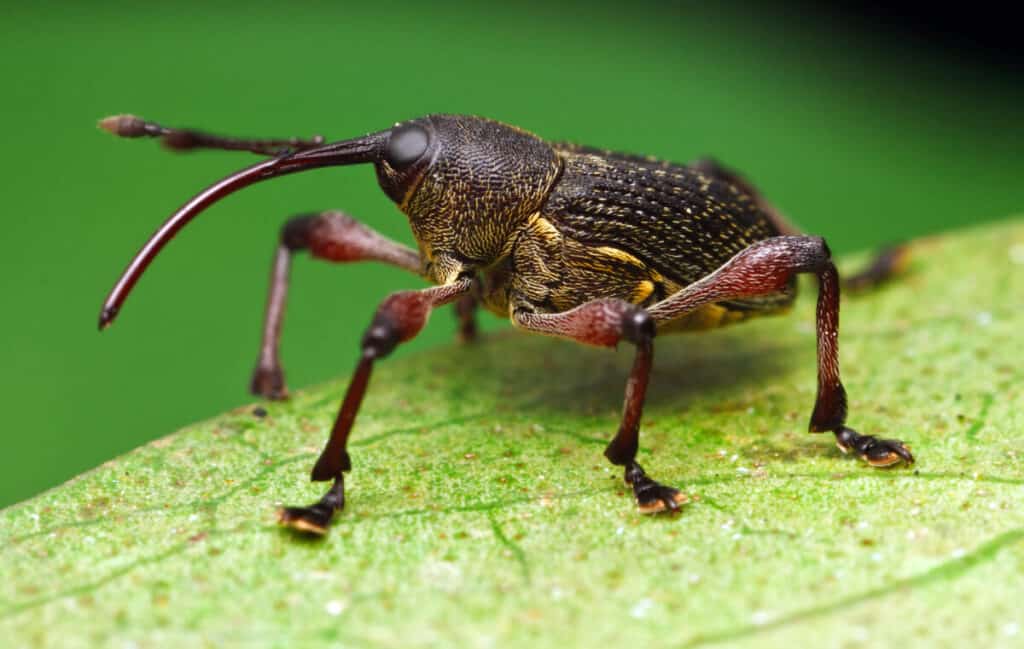Weevils are a common pest that feed on the leaves and stems of many types of vegetables. In this blog post, we’ll discuss how to identify and manage weevils on your vegetable plants.
What are weevils?
Weevils are small, dark-colored beetles that measure in size from a few millimeters up to 1/3 inch long. They belong to the family Curculionidae and are typically found feeding on leaves and stems of plants. Weevils have a long snout that they use to feed on the vegetable plants.
The larvae of these insects burrow into the stems or roots of their host plants and feed on them from within.
Weevils can be difficult to spot due to their small size, but you may notice them crawling around your vegetables or you may see tiny holes in the leaves where they have fed.
What damage do weevils cause on plants?
The larvae of the weevil bore into the stems and roots, weakening them and making them susceptible to disease. Weevils also feed on the leaves of plants, leaving behind small holes in their wake.
This can reduce the photosynthesis rate of the plant and severely stunt its growth. Besides this, weevils may spread viruses and other diseases from one plant to another through their feeding activity.
How to identify weevils on plants

Weevils can be difficult to spot because of their small size, so it’s important to look for signs of them on your plants.
Look for tiny holes in the leaves where the weevils have been feeding, or look for the beetles themselves crawling around the leaves and stems.
You may also notice larvae, or pupae attached to the stem or roots of your plants. These appear as white grubs with black heads and are usually found near the base of the plant.
Read more:
How to get rid of weevils
Pick off any visible weevils and discard them in a sealed bag or container.
Use insecticidal soaps or neem oil to kill adult weevils on contact.
Treat soil with an organic pesticide designed for controlling weevils, such as spinosad or diatomaceous earth (DE).
Nematodes are tiny worms that feed on weevils. These nematodes can be applied to the soil either as a liquid or granular solution. Be sure to follow the instructions carefully when applying nematodes.
Read more:
- How To Stop Insects Eating Plant Leaves
- How to Use Neem Oil and Save Your Plants
- How To Use Diatomaceous Earth In Potted Plants
- Insecticidal Soap vs Dish Soap for Pest Control
How to prevent weevils on plants
- Rotate crops regularly to avoid planting susceptible vegetables in the same spot year after year.
- Keep weeds and debris around the garden area to a minimum, as weevils may lay their eggs in these areas.
- Use row covers or floating row covers over vegetable plants to physically prevent adult weevils from reaching the foliage.
- Attract beneficial insects that feed on weevils, such as lacewings and ladybugs, by planting flowering plants near your vegetable garden.
- Remove infected plants immediately to prevent further spread of the pests.
Host vegetable plants for weevils
Weevils typically feed on leafy vegetables such as cabbage, kale, lettuce, spinach, and Swiss chard. They can also attack carrots, onions, potatoes, and other root vegetables.
Weevils may also feed on fruiting vegetables such as tomatoes and peppers. Squash, pumpkins, cucumbers, and melons are also susceptible to weevil infestations.
Natural predators of weevils
Natural predators of weevils include beneficial insects such as ladybugs, lacewings, and parasitic wasps.
References
- https://www.rhs.org.uk/biodiversity/vine-weevil
- https://growingorganic.com/ipm-guide/weevils/
- https://extension.umd.edu/resource/weevils-trees-and-shrubs

Fact Checked, Written, and Published by Kevin Rodrigues
Kevin is the founder of Gardening Mentor, a website that aims to teach people to grow their own food in a limited space. As a self-taught gardener, Kevin has spent several years growing plants and creating gardening content on the website. He is certified in Home Horticulture and Organic Gardening from Oregon State University. He has a Post Graduate Diploma in Horticulture and Landscape Gardening from Mumbai University.
Read more
